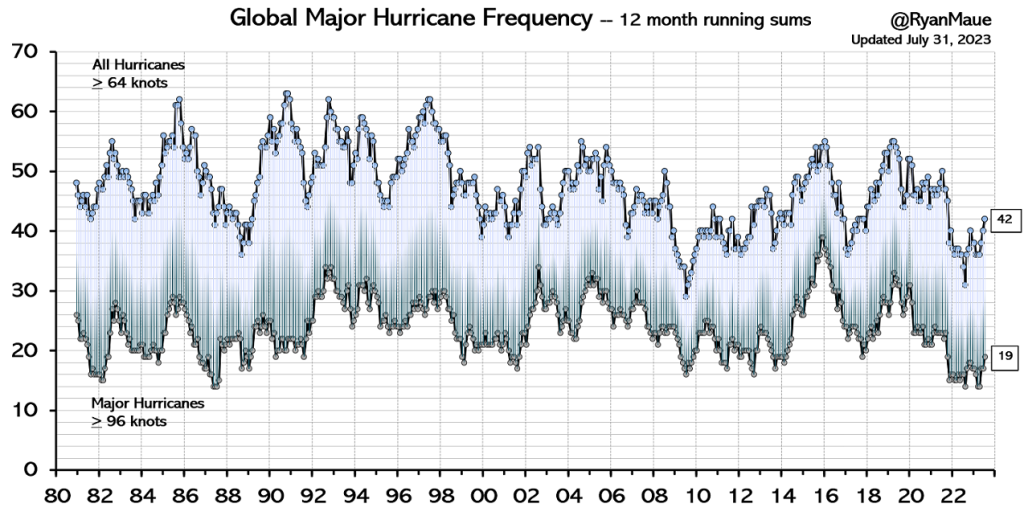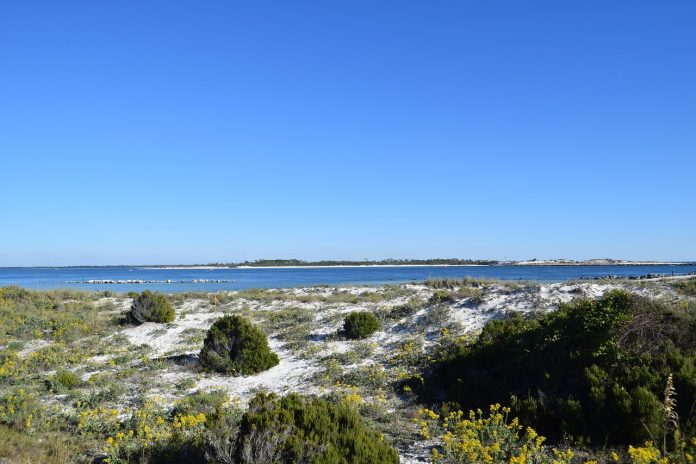By Linnea Lueken and H. Sterling Burnett
A recent article in The Washington Post (WaPo), titled “As climate change worsens, military eyes base of the future on Gulf Coast,” writes that a military base that was previously damaged by a hurricane is being rebuilt to be more weather-resilient. Weather resilient reconstruction makes sense, even though data does not support the claim made by WaPo that hurricanes are getting worse due to climate change. Building storm resistant infrastructure in storm-prone areas is always a good idea, regardless of the vagaries of climate change.
In 2018, Hurricane Michael struck Panama City, Florida, as a Category 5 storm, and destroyed a large part of the nearby Tyndall Air Force Base (TAFB). Since then, reconstruction has been underway at the base, which WaPo asserts is “threatened by climate change.”
WaPo claims the new base needs to “be able to withstand rising seas, stronger storms and other threats,” but while it is true that sea levels have been rising in that location, sea level rise itself is only part of the picture.
WaPo cherry picks sea level rise data to project an unusually high expected rate of rise in and around Panama City. Rather than looking at the entire 30-year time period over which climate change is measured, WaPo cites sea level data in the area beginning in 2010. During the previous 18 year of modest global warming, measured sea level rise at Panama City had slowed considerably from the previous decades and was virtually flat. It is interesting that WaPo chooses to highlight only a segment of recent sea level rise during the past 30 years of climate change, in fact beginning its estimates of the rate of rise at the period when the rate of rise in the area was at its nadir or slowest rate, over the entire time that sea levels have been continuously measured at Panama City.
The reason for the recent increase in sea level rise merits further research since other coastal tide gauges, in nearby Alabama, for instance, show record no rapid increase in the rate of rise after 2010. Since climate change is a global phenomenon and rates of sea level rise differ significantly from one tide gauge to the next abutting the same bodies of water, it is almost certainly the case that Panama City’s recent rate of increase is due to local conditions. As Climate Realism often points out, factors such as the rate of land subsidence (sinking) due to local geology and/or human-caused groundwater withdrawals and erosion, regularly result in significant changes in measured sea level rise at specific locations.
WaPo notes that builders undertaking the reconstruction of the TAFB are using the National Oceanic and Atmospheric Administration’s “high” rate of rise scenario when rebuilding and hardening the base in the face of future climate change. This high scenario is exceedingly unlikely, almost certainly being based on modeled RCP 8.5 emission scenarios, which Climate Realism has repeatedly explained, here and here, for example, to be highly implausible if not impossible. In addition, TAFB sits approximately 26 feet above sea level, so even an extremely unrealistic modeled rise of seven feet by the end of the century would be insufficient to compromise military operations at the base. Still, hurricanes do bring storm surges, so it is reasonable to plan for “better safe than sorry” scenarios for long-lasting infrastructure, especially in a location that is prone to tropical storms and hurricanes.
Moving on to WaPo’s assertion that storms are getting stronger. This is simply false, a claim clearly refuted by hard data on hurricane numbers and severity.
As covered by Climate Realism many times, here, here, and here, for example, existing data shows that hurricanes are neither getting stronger nor more are they forming more frequently. (See figure 1, hurricane frequency)

In addition, no trend of increasing tropical cyclone energy in the Northern Hemisphere is found in existing data. (see Figure 2, below)

WaPo goes on to discuss other efforts being undertaking, besides building stronger hurricane-proof structures, to decrease the chances coastal flooding and erosion, such as “efforts to restore dunes and sea grass meadows; the construction of a ‘living shoreline’ composed of natural materials such as plants and rock and the installation of submerged oyster reef breakwater that can reduce wave energy and erosion.”
These are good ideas, especially since coastal erosion is one of the factors that significantly impact local rates of sea level rise.
There is no justification for WaPo to falsely claim that climate change was responsible for the severity of Hurricane Michael in 2018, or that it is making such extreme storms more likely. Building stronger and well-planned infrastructure, especially on a military base located on a barrier island in an active hurricane area, and reducing coastal erosion are good ways to make the base more resilient to extreme weather and gradual sea level rise. This is true regardless of whether or not storms are getting more extreme.
















